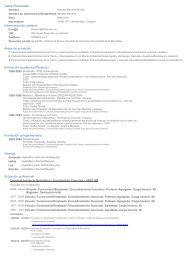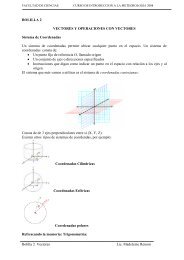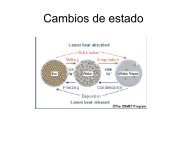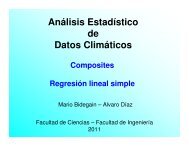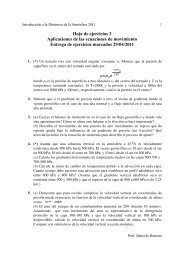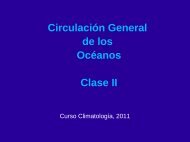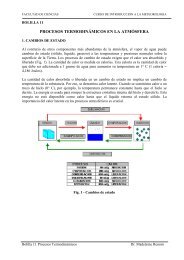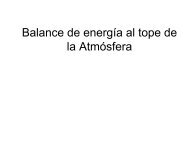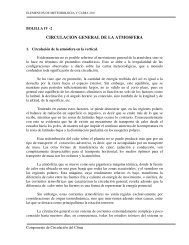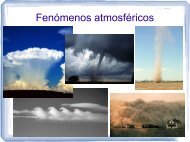Clasificación de Thornthwaite
Clasificación de Thornthwaite
Clasificación de Thornthwaite
You also want an ePaper? Increase the reach of your titles
YUMPU automatically turns print PDFs into web optimized ePapers that Google loves.
Climatología Práctico<br />
2012
• Esta clasificación fue propuesta por Charles W. <strong>Thornthwaite</strong><br />
(climatólogo y geógrafo americano), en el año 1948.<br />
• El gran aporte que hizo <strong>Thornthwaite</strong> con esta clasificación<br />
fue usar la variable ETP como si fuera una variable<br />
atmosférica mas, tal como lo es la precipitación.<br />
• Los valores <strong>de</strong> precipitación y las salidas <strong>de</strong> agua (por ETP),<br />
nos permiten hacer un balance hídrico en el suelo y<br />
<strong>de</strong>terminar la presencia y monto <strong>de</strong> excesos, déficit y<br />
superávits <strong>de</strong> humedad.
• Esta clasificación esta estructurada con cuatro índices que en<br />
su conjunto expresan las características climáticas <strong>de</strong>l lugar;<br />
los dos primeros expresan el régimen <strong>de</strong> humedad <strong>de</strong>l lugar y<br />
los restantes el régimen térmico. Por ejemplo:<br />
B 4 r A´a´<br />
Indice Global <strong>de</strong> Humedad<br />
Variación estacional <strong>de</strong> humedad (VEH)<br />
Concentración estival <strong>de</strong> la<br />
eficiencia térmica<br />
Indice <strong>de</strong> eficiencia térmica (ETP)
• n: necesidad (<strong>de</strong> la vegetación) <strong>de</strong> agua anual, expresada<br />
como la ETP.<br />
• d: total anual <strong>de</strong> déficits mensuales <strong>de</strong> agua<br />
d= ETP-ETR<br />
• s: total anual <strong>de</strong> los exce<strong>de</strong>ntes mensuales<br />
s= RR-ETR<br />
• I h : Indice <strong>de</strong> humedad<br />
I h =100*s/n<br />
• Ia: Indice <strong>de</strong> ari<strong>de</strong>z<br />
Ia=100*d/n<br />
El Ia es máximo cuando la ETR es nula; entonces la <strong>de</strong>ficiencia <strong>de</strong> agua es igual a las<br />
necesida<strong>de</strong>s <strong>de</strong> agua. El Ia pue<strong>de</strong> alcanzar un valor máximo <strong>de</strong> 100%.
• Este índice es una combinación entre I h e I a , pero se le da mas peso al Ih<br />
<strong>de</strong>bido a la existencia <strong>de</strong> otras fuentes <strong>de</strong> humedad, como la humedad en el<br />
subsuelo, napas freáticas, etc, que pue<strong>de</strong>n apalear el efecto <strong>de</strong> una eventual<br />
sequía.<br />
• Por lo tanto, Thronthwaite plantea:<br />
Cada exce<strong>de</strong>nte <strong>de</strong> agua en cierta estación podría ser suficiente para inhibir<br />
la falta <strong>de</strong> agua en la estación siguiente hasta un total <strong>de</strong> 10 mm.<br />
• El índice Im se calcula como:<br />
I m =I h -0.6*I a<br />
• Este índice se clasifica en nueve tipos climáticos, que van <strong>de</strong>s<strong>de</strong> tipo árido<br />
hasta el perhúmedo, según la siguiente tabla:
Tipo climático Letra Im<br />
Perhúmedo A Im>100<br />
Húmedo B4 100>Im>80<br />
B3<br />
80>Im>60<br />
B2<br />
60>Im>40<br />
B1<br />
40>Im>20<br />
Sub-Húmedo a Húmedo C2 20>Im>0<br />
Seco a Sub-Húmedo C1 0>Im>-20<br />
Semiárido D -20>Im>-40<br />
Arido E -40>Im>-60
• Se clasifica en 10 tipos, 5 para climas húmedos y 5 para climas secos:<br />
Simbolo Ia/Ih Significado<br />
r Ia10 Solo climas secos (C1,D,E). Poco o ningun exce<strong>de</strong>nte en<br />
cualquier estación.<br />
S<br />
w<br />
16,7
Simbolo Ia/Ih Significado<br />
s 2<br />
w 2<br />
Ia>33,3<br />
Ih>20,0<br />
Ia>33,3<br />
Ih>20,0<br />
Fuerte variación estacional <strong>de</strong> humedad, siendo el verano la<br />
estación mas seca.<br />
En climas húmedos; gran déficit estival.<br />
En climas secos; gran déficit invernal.<br />
Fuerte variación estacional <strong>de</strong> humedad, siendo el invierno la<br />
estación mas seca.<br />
En climas húmedos; gran déficit invernal.<br />
En climas secos; gran déficit estival.
• Es el tercer simbolo <strong>de</strong> la clasificación. Se establece a partir <strong>de</strong><br />
los valores <strong>de</strong> ETP, clasificandose en 9 tipos:<br />
ETP (mm) Símbolo Tipo <strong>de</strong> clima<br />
n>1140 A` Megatermal<br />
1140>n>997 B4` Cuarto mesotermal<br />
997>n>885 B3` Tercer mesotermal<br />
885>n>712 B2` Segundo mesotermal<br />
712>n>570 B1` Primer microtermal<br />
570>n>427 C2` Segundo microtermal<br />
427>n>285 C1` Primer microtermal<br />
285>n>142 D` Clima <strong>de</strong> tundra<br />
142>n E` Clima <strong>de</strong> hielo
• Es el cuarto símbolo. Se halla tomando el cociente entre la<br />
ETP <strong>de</strong> los meses <strong>de</strong> verano sobre la <strong>de</strong> todo el año, en<br />
porcentaje:<br />
ETP (verano)/ETP (anual)*100<br />
Valores menores a 48,0<br />
Entre 48,0 y 51,9<br />
Entre 51,9 y 56,3<br />
Entre 56,3 y 61,6<br />
Entre 61,6 y 68,0<br />
Entre 68,0 y 76,3<br />
Entre 76,3 y 88,0<br />
Valores mayores a 88,0<br />
Símbolo<br />
a`<br />
b4`<br />
b3`<br />
b2`<br />
b1`<br />
c2`<br />
c1`<br />
d`



